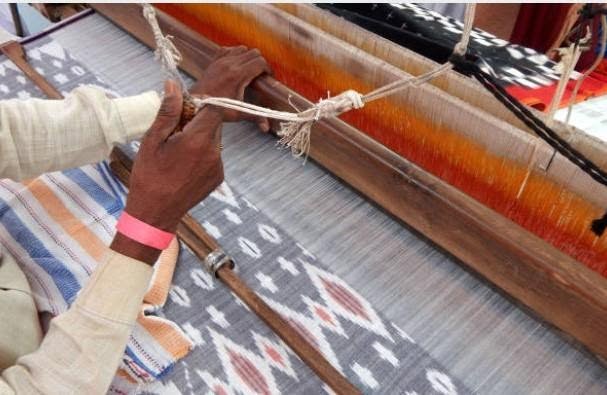India celebrates National Handloom Day on August 7th every year. This day marks the swadeshi movement date. The swadeshi movement and the national handloom day both hold significance for their legacy in Indian history. Since the pre-independence era, India is known for the magical weaves of the handloom workers. The present-day celebration of National Handloom Day was born out of the Swadeshi Andolan movement. The swadeshi movement date August 7th is the date chosen for the celebration of the national handloom day.
Quick Navigation
What is Swadeshi Andolan?
Swadeshi Andolan or Swadeshi movement is a part of the Indian independence movement. Swadeshi is a Hindi term that is a combination of two words – ‘swa’ and ‘deshi’. The meaning of swadeshi is ‘my country’s’ or ‘made in my country’. Thus Swadeshi Andolan was mainly raised to create awareness about Indian-made products, especially handlooms.
The Swadeshi movement was started by Mahatma Gandhi. The Swadeshi Andolan was a consequence of the partition of Bengal. The British rulers implemented their divide and rule to split India. As a part of this, they partitioned West Bengal. They also wanted to curb the Indian handloom industry. Thus, they targeted Bengal, the main production center of the finest muslin cloth made by handloom workers.
The British rulers cut off the thumbs of master handloom workers so that they do not produce muslin on the handloom.
Instead, they forced Indians to import the muslin from Britain. The British muslin was of inferior quality compared to India’s. This atrocity also led to the loss of livelihoods of thousands of handloom workers.
To raise the voice against this curbing of Indian handlooms, on 7th August 1905 – the swadeshi movement date, Mahatma Gandhi started the Swadeshi Movement. As a part of this, Indians gathered in countless numbers and boycott foreign goods, including textiles. They started producing handlooms on mass production and used to wear them as a protest against British rule.
The Swadeshi movement was known by various names in different states of India.
For instance, in Andhra Pradesh, it was called as Vandemataram movement. People used to chant the slogans of Vandemataram and boycott the foreign goods in the center of the villages or towns.
The Swadeshi movement played an important role in unifying Indians in the Independence fight. Besides, it was the reason behind the National Handloom Day celebrations.
Suggested Reading: Significance of Elephants in Indian Culture
What is Handloom Meaning?
Handloom means the weavers weave cloth on a unique set up of wooden blocks, fibers, and ropes/threads skillfully constructed and arranged. The handloom workers fill the fiber rolls and move the rope of the handloom and the blocks using their hands with great skill and mastery from one side to the other. In this process, the handloom fabric starts forming slowly. In this process, nowhere does electricity or any modern machines come into the picture. Depending on the type of handloom, it can take anywhere from 3 days to months to complete one handloom weave.

Significance of National Handloom Day
The increasing craze towards westernization had reduced the affinity of Indians for handlooms. As a result, many handlooms were shut down, and the handloom workers committed suicides. The handloom industry plays a significant role in the Indian economy. After agriculture, it is the handloom industry that is the livelihood of many families in villages.
To let the world know about the legacy of handlooms and bring light to the families of handloom workers, the Indian government under the leadership of Prime Minister Narendra Modi devised the National Handloom Day. The first National Handloom Day was inaugurated on 7th August 2015 by Prime Minister Narendra Modi at the Centenary Hall of Madras University in Chennai.

Over time, many celebrities and politicians supported this event, thus giving it enough boost and popularity, the day deserves.
Today, National Handloom Day is a notable celebration in India that is enthusiastically celebrated by youth too.
Suggested Reading: List of Indian Handicrafts
The Handloom Export Promotion Council
The handloom sales outside of India are governed by The Handloom Export Promotion Council.
It is a nodal agency dedicated to the exports of Indian handlooms and to cater to the needs of handloom workers.
The National Handloom Day celebrations take place under the aegis of The Handloom Export Promotion Council (HPEC). The council organizes various events and promotion activities to increase awareness about Indian handlooms to foreign countries.

Currently, a major part of Indian handlooms is exported to the USA, UK, Germany, Italy, France, Japan, Saudi Arabia, Australia, Netherland, and UAE. Singapore, Myanmar, Nepal, Bhutan, Malaysia, Bangladesh, and Sri Lanka are also other countries that import Indian handlooms.
There is a wide range of handloom textiles of India such as sarees, dhotis, lungies, sarongs, shawls, stoles, scarves, fabrics, dress materials, garments, and carpets.
The motto of The Handloom Export Promotion Council is – “When the world starts dreaming, Our hand starts weaving.”
60 Milestones after India’s Independence
Facts About India Handloom Industry
- Indian handloom is the second largest industry after agriculture. It is a livelihood of 31.45 lakh families, as per the Fourth All India Handloom Census 2019-20.
- People of every religion of India are involved in the handloom industry. It is one of the industries where we can witness religious diversity and unity.
- Four States of India account for 18 lakhs of all weaver households in the country. These States are Assam (10.9 lakhs) households, West Bengal (3.4 lakhs), Manipur (2.1 lakhs), and Tamil Nadu (1.7 lakhs).
- Currently, the government of India introduced many schemes for the welfare of handloom workers. However, to promote the handloom industry, there needs to be more support from the people towards using and promoting them.

Reasons to Wear Handloom Sarees
A saree is an eternally beautiful piece of garment for an Indian woman. When the saree is handloom woven, the beauty of the woman amplifies.
Here we give 6 reasons to wear handloom sarees.
- Handloom sarees are sustainable. They do not damage the environment. All colors, yarns, and dyes used in handloom sarees are eco-friendly.
- Handloom sarees last for generations together. It is a common practice in many Indian families that sarees worn by grandmothers and mothers are passed on to their children.
- Handloom is the livelihood of lakhs of families in India. When you choose handloom sarees, you are directly helping them to make their ends meet.
- India has a tropical climate. Handlooms help to keep our body cool in summer and warm in winter automatically. Some of the handlooms are also proven to provide relief from respiratory diseases like asthma and skin rashes.
- Handloom is the legacy of India. Many politicians, leaders, and celebrities wear handloom sarees as they impart the utmost dignity.
- The handloom industry plays a crucial role in the Indian economy. Synthetic cloth harms the environment by its water consumption and chemical usage. By ditching the foreign and synthetic cloth and shifting to handlooms, we can promote the Indian economy and save the environment.

Ideas to Celebrate National Handloom Day
As a responsible citizen of India, make sure to participate in National Handloom day celebrations to your possible extent. Here are some ideas to celebrate national handloom day:
- Participate in handloom day fairs and exhibitions. You can either buy the products and support the industry. Or you can also learn the handlooms meaning and intriguing details about handloom workers and weaves.
- Create awareness about handlooms by forming teams. Organize campaigns in colleges, offices, and public spaces to educate people about the handlooms meaning and benefits of supporting the handloom industry.
- Gift handloom products to your near and dear. There are a plethora of gifts available in the handloom section. Right from sarees, dhotis, kurta pajamas, to shawls, masks, towels, bedsheets, and home décor items, the range of handloom gifts spoils you with choice.
- Teach the handlooms meaning and importance of using handloom cloth to your children. Explain to them the relationship between the National Handloom Day date and the swadeshi movement date. Present handloom documentaries, short films, and videos that showcase the difficulties of handloom workers and the process of handloom weaving to children. Explain the beauty and the greatness of Indian handlooms.
- Participate in social media discussions about national handloom day. Raise your voice and share your thoughts on how to improve the conditions of handloom workers in India. Narrate the beauty of handlooms meaning and the greatness of Indian handlooms to the global audience.
- Ranging from bridal wear of Benarasi to daily wear of Bengal and Andhra, the list of Indian handlooms is long. There is one handloom for every occasion of life. On this National Handloom Day, take a pledge to wear handloom as and when possible. Let’s be proud to be born in a nation where weavers weave magic with their hands and continue the legacy.
Quotes on Indian handloom
“I do regard spinning and weaving as a necessary part of any national system of education.”
Mahatma Gandhi
“The handloom weaving is in a dying condition. Everyone admits that whatever may be the future of the mill industry, the handlooms ought not to be allowed to perish”.
Mahatma Gandhi
“You see, when weaving a blanket, an Indian woman leaves a flaw in the weaving of that blanket to let the soul out.”
Mahatma Gandhi
“We all have our own life to pursue, our own kind of dream to be weaving, and we all have the power to make wishes come true, as long as we keep believing.”
Louisa May Alcott
“A good life is like a weaving. Energy is created in the tension. The struggle, the pull and tug are everything.”
Joan Erikson
Frequently Asked Questions
Swadeshi movement aimed at boycotting foreign products and promoting the usage of Indian products, especially textiles.
National Handloom Day is celebrated to share with the world the beauty of Indian handlooms and to promote them on a global dais.
7th August is chosen as the National Handloom Day because it was on this date in 1905, the Swadeshi movement was started.
Prime Minister Narendra Modi started the handloom day at the Centenary Hall of Madras University in Chennai.
The first National Handloom Day was inaugurated on 7 August 2015 by PM Shri Modi.
At AvaniGo, we are passionate about India and its mesmerizing culture. We intend to share the greatness of Indian culture through our articles. To learn more about us and contribute to our website, email us at hello@avanigo.com.

